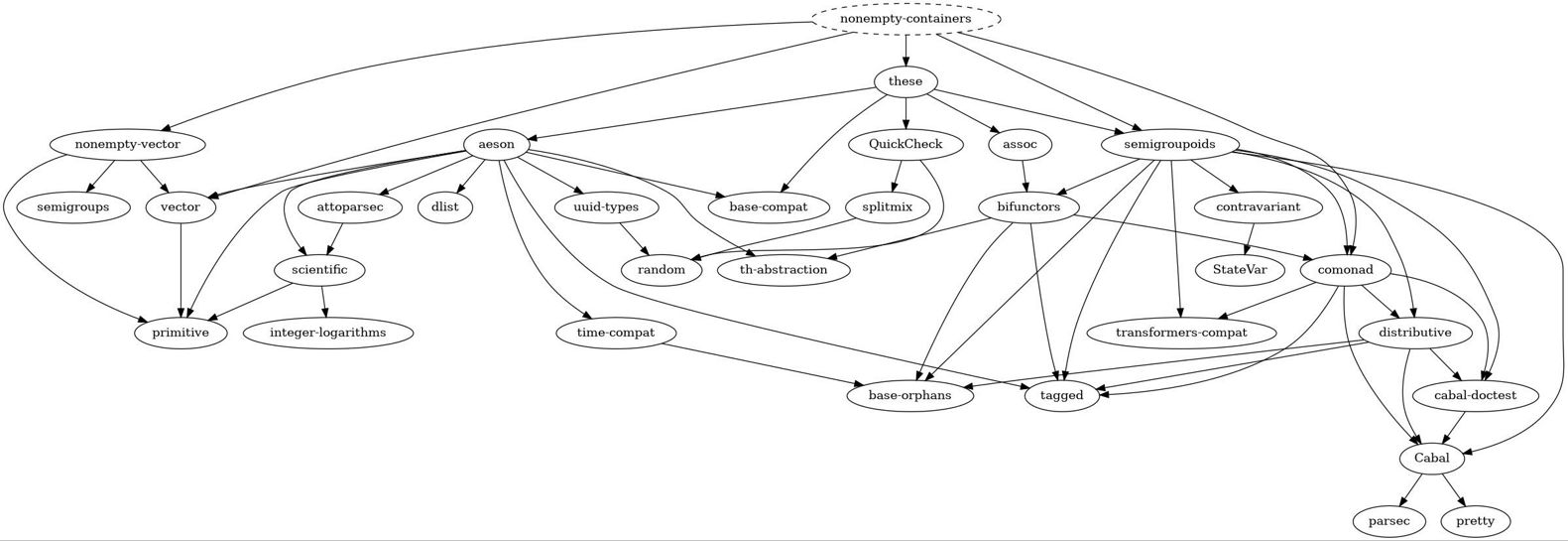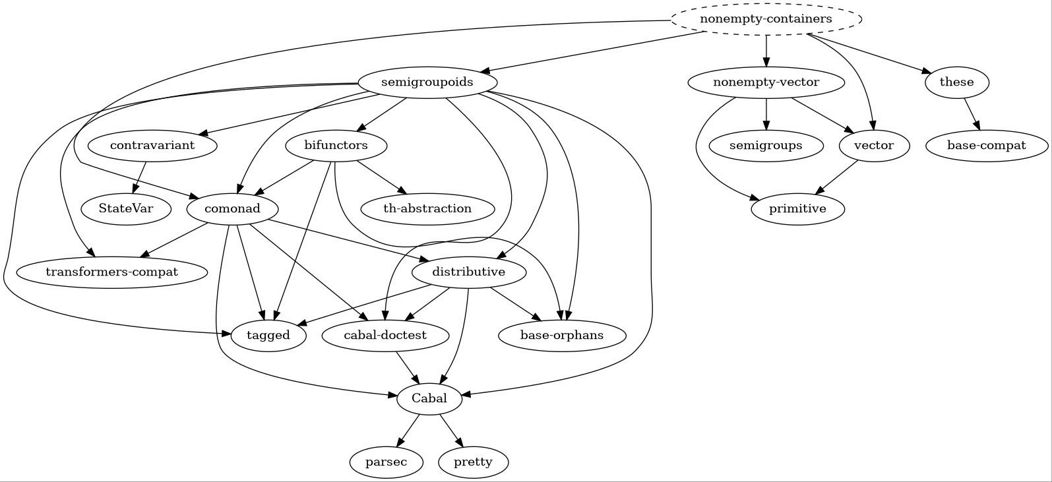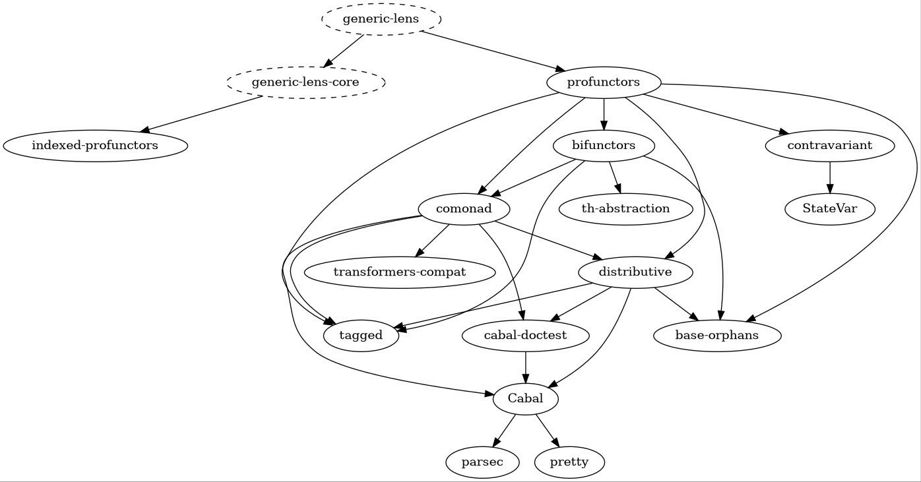Wide Haskell: Reducing your Dependencies
This post describes my recent experiments in actively reducing the number of depedencies in my Haskell projects to achieve a "wide" (not deep) dependency graph. Overall it was less effort than I thought it would be, and the results were surprising. Aura, one of my larger projects, saw the following benefits:
| Criterion | Before | After | Change |
|---|---|---|---|
| Dependencies | 140 | 98 | 30% |
Binary Size (-O0) | 30.9mb | 26.2mb | 15% |
| Compile Time | 31s | 19s | 39% |
This website (also a Haskell project), improved as well:
| Criterion | Before | After | Change |
|---|---|---|---|
| Dependencies | 169 | 121 | 28% |
| Binary Size | 44.3mb | 34.9mb | 21% |
| Compile Time | 6.9s | 5.9s | 15% |
These changes were possible, for the most part, without sacrificing any functionality or convenience. If the dependencies weren't needed, why keep them?
Why reduce dependencies?
Here are reasons in order of increasing importance, measured by how much of humanity's time can be affected:
- Smaller binaries.
- Performance improvements from reduced complexity / novelty.
- Faster CI + deployment pipelines.
- Faster website loads (for GHCjs projects).
- Faster compile times.
- Less surface area for bugs you didn't write.
- You are less bound to the lifecycles of other projects.
Dependencies can empower your code, but they are also a liability. Bitrot is real. Taking on a dependency is a marriage of sorts: you must treat that code as if it's your own. Its concerns are your concerns. Likewise, the author of that library is now your partner. Their concerns are your concerns and vice versa. If they are not interested in maintaining their half of the relationship, then their library should be avoided.
A Definition of Bitrot
Bitrot is a universal concern, as it relentlessly consumes all code over time. But what is it? Say, code that worked last year no longer does. We open it up, and see that nothing has changed. The characters are all identical. We're not facing a logical bug. What happened?
Bitrot is the World leaving your code behind.
Code is just a spell in a book. To become real, it must move through the World. Yet the World is ever-changing.
An example: a government agency invests a large sum to implement a system on Windows 95 that becomes the heart of their Department. Everyone uses it, and soon the Department can't function without it. They intend this arrangement to be permanent. Eventually, Microsoft drops support for Windows 95, and with immense effort the Department gets their software ported to Windows XP. Later, support for XP is dropped and they must upgrade again. However, by this point the software is built with such aged technologies that the port is no longer possible without a significant overhaul. Furthermore, the firm that wrote the software in the first place no longer exists. What is the government agency to do in this situation?
Combating Bitrot in Haskell
When it comes to Haskell, the only set of libraries that are guaranteed to never bitrot are those in the GHC Platform, like base, bytestring, containers, etc. GHC devs might beg to differ, but I'm speaking from the perspective of a downstream user who only consumes official releases.
So, by definition, the more a library relies on base and the other core libraries, and less on third-party libraries, the less likely the World will break your code over time.
The danger is greater in the Haskell world than say in Java, since in Haskell, anything that is not the most recent version is implicitely deprecated. "Old = Stable" is not a safe assumption in Haskell. Bug fixes are typically not back-ported to older major versions (with the occasional exception of GHC itself). When reporting a bug, the first question the library author asks you is:
Are you on the latest version?
If you're not and you can't be, then the author can't help you. So, while Stackage Snapshots and Cabal Freeze Files let us choose whatever stable package set we want, staying back on old versions of GHC or old libraries is not inherently safer. If you do, you lock yourself off from all upstream improvements, and eventually the base library will eat you.
Dependencies of Note
Here I highlight a few libraries that I removed, how the removal went, and what the effect was. This is not a condemnation of these libraries. In fact, I love them and highly recommend all three! However, in the spirit of simplicity, I decided that I could afford to lose them.
servant-client
Servant shines when you are sharing your API code, when you are writing both the server and the client that consumes the API of that server. If you're just writing a few client-side calls, direct usage of http-client is sufficient. Here is the commit where I did the replacement.
Here is the dependency graph of http-client:

And here is that of servant-client:

Notice in particular that this pulls QuickCheck, http-api-data (and its tree), and kan-extensions (and the transitive kmettoverse) into your code.
Removal of servant-client freed 22 dependencies and reduced binary size by about 9%.
nonempty-containers
I highly recommend being aware of emptiness at the type level. nonempty-containers helps with this, and I used NESet a lot in Aura. However, the original type, NonEmpty, is present in base. Could I relax the uniqueness constraint and keep to base? Yes I could.
This freed 4 dependencies and reduced binary size by ~1%.

This tree looks scary, but can be simplied via passing the right flags for the these library:

Still, semigroupoids pulls in some of the kmettoverse.
generic-lens
This library is very cool, and offered an immense convenience in the Aura.Security module. Elsewhere, however, I was using it in combination with DuplicateRecordFields as a solution to the "Record Problem":
It was especially silly where vanilla Haskell would suffice:
-pure . zip aurInfos $ aurPkgs ^.. each . field @"version"
+pure . zip aurInfos $ map spVersion aurPkgsA coworker and I recently had a debate about naming, and he convinced me that there is no Record Problem in Haskell given well-crafted, greppable function names. Following that idea, I made all my record fields unique again, and removed generic-lens. This freed 7 more dependencies and reduced binary size by another 2%.

I see you, profunctors.
Responsiblities as a Library Author
Software bloats over time unless proactively minimized. I believe that we library authors can help with this from our end using the following rules-of-hand:
Avoid including QuickCheck instances in your library
If orphan instances are ever okay, it would be here. Please keep the Arbitrary instances out of your library, so that downstream library authors are not affected by the release schedulde of QuickCheck.
Avoid depending on lens
lens is great for applications, if you can prove that you need it. microlens is sufficient for most uses. If you want to provide Lenses for the data types in your library, please handwrite them. If your library needs lens in order to provide certain functionality, then consider a foo-lens child library so that users can consume your types without buying a lens dependency they might not have asked for.
Avoid adding a dependency just for one function
This is Open Source: we're allowed to copy code. It's just as easy to inline the utility function you're looking for in some internal Utils module of yours.
But what about bug fixes!
Yes, you have a point, so use your best judgement.
Avoid "opt-out" features
Features should be "opt-in".
If your library provides "bonus" features that incur a hefty extra branch of dependencies, then consider hiding that feature behind a Cabal Flag set to False by default:
flag remote-configs
Description: enable loading of config files from HTTP URLs
Default: False
Manual: True
library
...
if flag(remote-configs)
exposed-modules:
Configuration.Utils.Internal.HttpsCertPolicy
build-depends:
, connection > 0.2
, ...Or better yet, put that feature in a child library. This way, the user has complete choice and awareness of what they're attaching to when they depend on your library.
Conclusion
The dependency graph of Aura now looks like this:

A significant improvement from before, trust me. http-client-tls still brings in its own little universe, but that may be unavoidable. I am happy overall that the "depth" of Aura's graph has decreased. With fewer dependencies, Aura is less likely to break as the ecosystem evolves. I'll end with this take-away:
The greater the width-to-depth ratio of your project's dependency graph, the less bound to the World it will be.